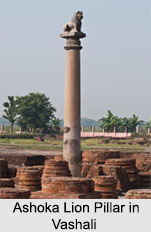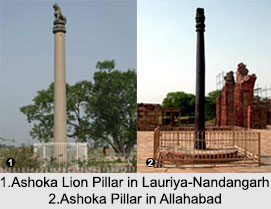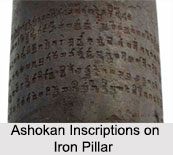 The Pillars of Ashoka are a series of columns that were placed throughout the Indian subcontinent; some pillars fall under the regions of Nepal. These columns carry the inscriptions of Mauryan Emperor Ashoka during his reign from 268 to 232 BC. While the inscriptions reveal some facts of the Mauryan dynasty, these inscriptions also carry the message of peace which was propagated by Ashoka under the influence of Buddhism.
The Pillars of Ashoka are a series of columns that were placed throughout the Indian subcontinent; some pillars fall under the regions of Nepal. These columns carry the inscriptions of Mauryan Emperor Ashoka during his reign from 268 to 232 BC. While the inscriptions reveal some facts of the Mauryan dynasty, these inscriptions also carry the message of peace which was propagated by Ashoka under the influence of Buddhism.
All the pillars of Ashoka were built at Buddhist monasteries, many important sites from the life of the Buddha and places of pilgrimage. Some of the columns carry inscriptions addressed to the monks and nuns. Some were erected to commemorate the visits of Ashoka. The pillars of Ashoka had been historically relevant, for it carries the peace messages of the emperor that shall guide the mankind towards warless and peaceful living. Also these pillars reflect some light on the lifestyle of the Maurya Empire, where the edict describes about the Rajans of Mauryan Empire and their Rajya.
Ashoka and Buddhism Ashoka ascended to the throne of Mauryan Empire in 269 BC. He was reputedly a tyrant at the outset of his reign. After campaigning in Kalinga, Ashoka converted to Buddhism in regret for the loss of life. Earlier, Buddhism was not a state religion but with Asoka"s support, the religion spread rapidly.
 Architecture of the Pillars of AshokaStructures of Ashokan Pillars
Architecture of the Pillars of AshokaStructures of Ashokan Pillars
Pillars of Ashoka are of two types. While some of them are sandstone pillars made up of two types of sandstone; the other include the iron pillar which is one singular iron block curved in the form of a pillar with a height of seven feet and above. In Delhi two such pillars were found which were originally located in the outskirts of Delhi. One such pillar was located in Meerut while the other was located in Haryana, which was transported to the city of Delhi during the reign of Ferozshah Tughlaq.
Architecture of the Pillars of Ashoka
Some of the pillars of Ashoka are made up of red and white sandstone which is a specialty of Mathura, while the others are made up of buff coloured fine grained hard sandstone with small black spots quarried in Chunar near Varanasi. The uniformity of the style of construction particularly of the pillar heads reveal that they have more or less been constructed by the same craftsmen of the same region having same kind of skills.
Moreover, these pillars had been significant as they represent unique architectural innovation when either stone or iron is carved into one single unit. Along with separate looks these pillars varied from region to region. While it is different in Vaishali which carries a lion at the head, the other pillars sometimes do not carry such symbols.
 Source of inspiration for Ashokan Pillars
Source of inspiration for Ashokan Pillars
The origins of inspiration for the iconic Ashokan Pillars, which stand as monumental proof to ancient Indian art and architecture, have sparked scholarly discourse over the years. Diverse influences, including those from Achaemenid Persia and Hellenistic Greece, have been identified as shaping the distinct features of these historical pillars.
A significant point of consideration is the impact of Achaemenid Persia on the design of Ashokan Pillars. The resemblances between the column capitals at Persepolis and those supporting the roofs of these pillars have drawn attention. Notably, the "rather cold, hieratic style" of the Sarnath Lion Capital, a hallmark of Ashoka`s reign, displays evident Achaemenid and Sargonid influences. The interaction between India and the Achaemenid Empire during the period spanning from approximately 500 BCE to 330 BCE, which coincides with the Achaemenid conquest of the Indus Valley, underscores the potential for cultural exchange and cross-pollination of artistic ideas.
Hellenistic elements have also left their mark on the Ashokan Pillars. The abaci of select pillars, such as the Rampurva bull, the Sankissa elephant, and the Allahabad pillar capital, showcase ornamental bands reminiscent of motifs seen in Greek and Near-Eastern arts. The bead and reel pattern, ovolo, flame palmettes, and lotuses find their origins in these artistic traditions. Similar design examples are observable in remnants from the Mauryan capital city of Pataliputra, further emphasizing the cross-cultural influences at play.
Another intriguing source of inspiration is the Bharhut stupa railing relief, which portrays a regal figure astride a horse bearing a Garudadhvaja. The Heliodorus pillar, often referred to as the Garudadhvaja, dating back to the 2nd century BC, stands as a pivotal example of early stone pillar craftsmanship that has been designated as a dhvaja.
Ashoka`s own edicts reinforce the precedent of inscribing words onto stone slabs or pillars, suggesting that the tradition of crafting stone pillars predates his reign. These profound inscriptions underline the enduring legacy of stone carving as an art form with deep-rooted historical significance.
Pillars of Ashoka without InscriptionsPillars of Ashoka with Inscriptions
The pillars of Ashoka with inscriptions are mentioned below:
Vaishali: was a city that comes under the state of Bihar at present day. Now this place is an archeological site and it is a part of Tirhut Division.
Lauriya-Nandangarh: This place, which is also called Lauriya-Navandgarh, is a part of Champaran district of Bihar.
Lauriya-Araraj: This place also comes under Champaran district in Bihar state and it is often called Lauriya-Areraj as well.
Delhi-Meerut: The pillars of Ashoka in Delhi are a series of edicts on the teachings of Buddha.
Delhi-Topra: The pillars of Ashoka in this region bear the same features like the above one.
Allahabad: The pillars of Ashoka in Allahabad originally are from Kosambi, which was one of the greatest cities of India from late Vedic period until the end of Maurya Empire with occupation continuing until the end of Gupta Empire.
Lumbini: Lumbini is a Buddhist pilgrimage site in Nepal.
Sarnath: Sarnath is located 10 kilometres north-east of Varanasi near the confluence of the Ganges and the Varuna rivers in Uttar Pradesh. The deer park in Sarnath is where Gautama Buddha first taught the Dhamma, and where the Buddhist Sangha came into existence through the enlightenment of Kondanna.
Sanchi: The Sanchi stupa is a Buddhist complex, which is popular for its stupa, located on a hilltop of Sanchi town in Raisen District of Madhya Pradesh.
Rampurva: The Rampurva capitals are the capitals of a pair of Ashoka Pillars. The archaeological site is called Rampurva, and it is located in the West Champaran district of Bihar, which is situated very close to the border with Nepal. The two capitals are currently in the Indian Museum in Kolkata.
Nigali Sagar: Nigali Sagar is an archaeological site in Nepal containing the remains of a pillar of Ashoka.
Amaravati: City Amaravati is located in Guntur District in Andhra Pradesh.
Pillars of Ashoka without Inscriptions
Some of the fragments of the pillars of Ashoka have been discovered without inscriptions and they are Kausambi, Gotihawa, Bodh Gaya, Pataliputra, Bhawanipur Rupandehi, Amaravathi Mahachaitya.
Capitals of the Pillars of Ashoka
The Capitals of the pillars of Ashoka, ordered chronologically and based on stylistic and technical analysis are Vaishali Lion, Sankissa Elephant, Rampurva Zebu bull (it is now placed in Rashtrapati Bhavan), Lauria Nandangarh Lion, Rampurva Lion, Four Lions crowned by a wheel from Sanchi and the Lion Capital of Ashoka from Sarnath.
Major Pillar Inscriptions of the Ashokan Pillar
Asoka"s 7 pillar inscriptions have been found at Kausambhi (Allahabad), Topra (now Delhi), Meerut (now Delhi), Lauriya-Araraj, Lauriya-Nandangarh, Rampurva (Champaran) and Nigali
Sagar. The major pillar inscriptions are:
Asoka"s principle of protection to people
Defines Dhamma as minimum of sins, many virtues, compassion, liberality, truthfulness and purity
Abolishes sins of harshness, cruelty, anger, pride etc
Deals with duties of government officials
List of animals and birds which should not be killed on some days and another list of animals which cannot be killed on any occasion. Describes release of 25 prisoners by Ashoka
Works done by Ashoka for Dhamma Policy. He says that all sects desire both self-control and purity of mind
Minor Inscriptions of Ashokan Pillars
Minor pillar inscriptions have been found at Sanchi, Sarnath, Kausambhi and Rummindei/ Lumbini. These contain inscriptions which record the dedication.



















